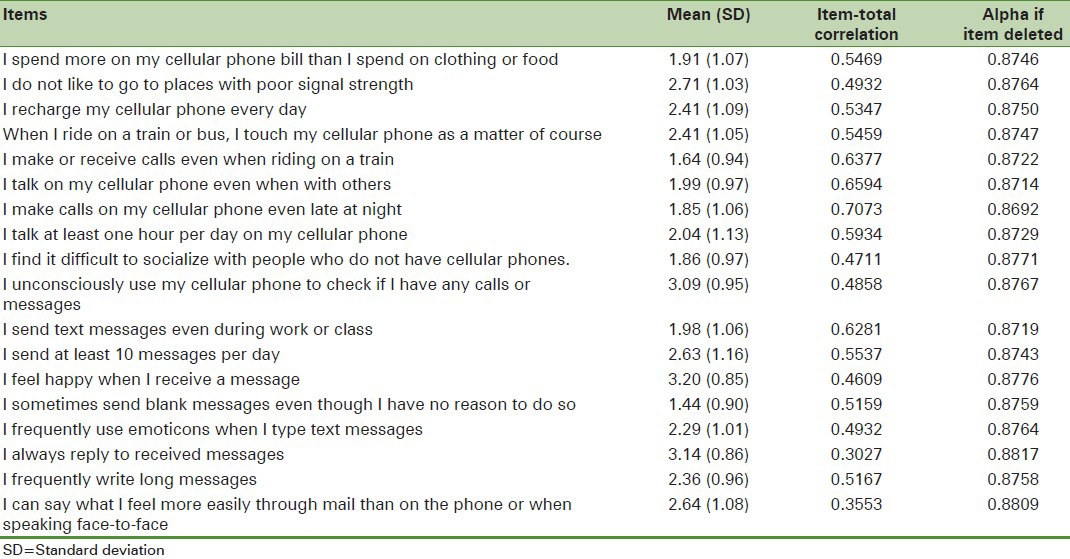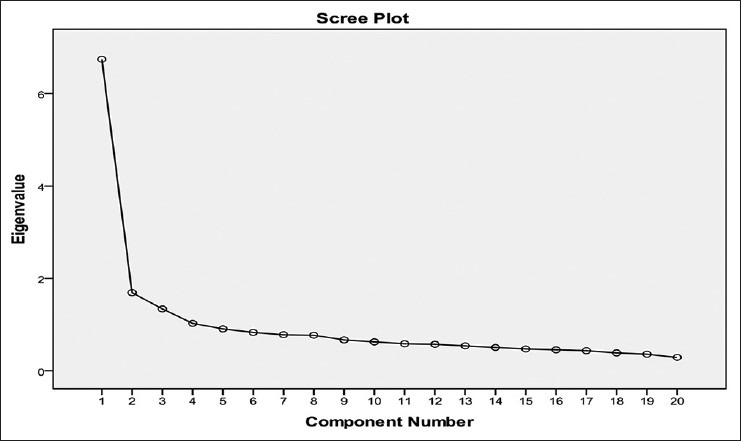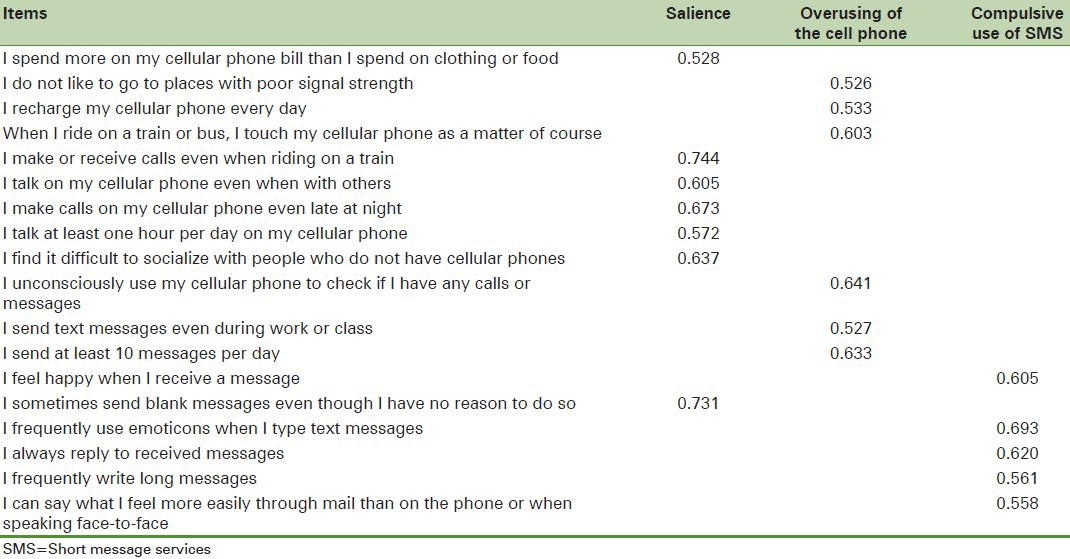Abstract
Background:
A number of diagnostic scales or questionnaires have been developed in recent years, to assess mobile phone dependency. A valid and reliable assessment instrument for correspondence of Iranian culture is essential. The aim of our study is to validate the Iranian version of the Cell Phone Dependency Questionnaire (CPDQ).
Materials and Methods:
In this cross-sectional study, data were collected from 784 students, who were studying in four main Isfahan Universities. The participants completed the demographic questionnaire, CPDQ, anonymously. To analyze the data we used concurrent validity, factor analysis, internal consistency, split-half, and test–retest.
Results:
We extracted three factors including Salience, Overusing of the cell phone, compulsive use of SMS. Cronbach's alpha of the CPDQ was. 88 (Cronbach's alpha of the factors were 0.85, 0.70, and 0.76, respectively).
Conclusion:
The CPDQ proved to be a reliable questionnaire to assess the extent of problems caused by the ‘misuse’ of the cell phone in Iranian society.
Keywords: Cell phone dependency, students, validation
INTRODUCTION
The ‘communication era’ is a chosen title for the modern world by some experts, who are talking through the mass media. Short Message Services (SMS) transport a message between people within a few seconds via mobile phones.[1]
Over the last decade the usage of mobile phones has dramatically increased, and therefore, the cell phone has become an important part of human life.[2,3,4] However, we should not overlook its unpleasant and destructive consequences, especially in the social and cultural fields.[5]
Long-term usage of a cell phone may reduce visual field attention, there is a possibility of growth of brain tumor,[6] increased behavioral impairment, and psychological problems;[7,8,9] moreover, it may cause depression, anxiety, and low self-esteem.[10] It is also associated with elevated traits of extraversion and neuroticism.[11]
Researches on the addictive spread of cell phones have shown that girls’ addiction is more than boys and they suffer from a high level of anxiety and insomnia.[12,13]
Billieux et al. (2008), validated a new questionnaire called the Problematic Mobile Phone Use Questionnaire (PMPUQ) to assess mobile phone dependency. It measured four various aspects of cell phone addiction including, prohibited use, dangerous use, dependence, and financial problems. This questionnaire had 30 items and its internal reliability was illustrated by Cronbach's alpha, which varied from 0.85 to 0.90.[14]
Some other questionnaires have been designed to measure mobile phone dependency such as Mobile Phone Use Survey (MPS),[15] Problematic Cellular Phone Use Questionnaire (PCPU-Q),[4] and Cellular Phone Dependency Questionnaire (CPDQ),[16] These measure this phenomenon according to various definitions of behavioral addiction or cell phone dependency.
The MPS questionnaire had been designed by Bianchi and Phillips (2005). It has 27 items that measure symptoms such as cell phone dependency, withdrawal symptoms, negatives effect on health, and the negative effects of cell phone on the social, financial, and vocational status. Reliability has been reported to be equal to 0.91, using Cronbach's alpha.[15]
The Problematic Cellular Phone Use Questionnaire (PCPU-Q) is a self-administered questionnaire. It has been designed by Yen et al. (2009), and has 12 items. PCPU-Q was designed to determine the occurrence of symptoms of problematic cell phone use based on the Diagnostic and Statistical Manual of Mental Disorders (DSM)-IV-TR. Internal consistency, using Cronbach's alpha for the seven symptoms of problematic CPU, was 0.854.[4]
The CPDQ questionnaire has been created by Toda et al. (2004), which has 20 items. Cronbach's alpha of the questionnaire varied from 0.80 to 0.93.[16]
On account of the few researches that have been done in the field of cell phone use, a valid and reliable questionnaire based on Iranian culture, is needed, to differentiate the normal users of cell phones from the dependent users, based on psychological effects. Kawasaki et al. (2006), indicated the psychometric properties of the Cellular Phone Dependency Questionnaire; some studies have been done using inappropriate methods.[17] Toda et al. conducted a study on the psychometric properties of the CPDQ, involving only female university students, with several limitations.[18]
We found neither study to support the contents nor psychometric aspects of the CPDQ in Iran. The aim of this research was to validate the psychometric properties of CPDQ.
MATERIALS AND METHODS
This study was a cross-sectional design and sampling from a target population (Isfahan University Students) and was based on a stratified random sample. A total of 780 participants completed the questionnaires from four main universities of Isfahan province, including Isfahan University of Medical Sciences, Isfahan University, Isfahan University of Technology, and Islamic Azad University Khorasgan (Isfahan).
This study included participants who had used the mobile phone at least once a day in the last year. Exclusion criteria were subjects who had had severe physical problems, apparent disability or were under treatment due to a specific psychiatric disorder during the last year. To calculate the sample size, the confidence level and study power were determined, 95 and 80%, respectively.
The level of mobile phone dependency was measured using the CPDQ. The demographic section consisted of gender, age, year of study at the university, marital status, and time spent on mobile phone.
The CPDQ is a 20-item self-report. The items reflect typical behaviors of addiction. It was used the first time by Toda et al. (2004). The subjects responded to each item on a five-point Likert spectrum scale. A higher score indicated a stronger tendency toward cellular phone dependency. The 20-item instrument provided different dimensions of the mobile phone dependency phenomenon. Toda et al. reported that the internal consistency (Cronbach's alpha) of the CPDQ was. 86 and its test–retest reliability was also reported to be satisfactory.[17]
To perform this research, first the CPDQ was translated into Persian in parallel by two specialists, native Iranian psychologist translators, fluent in both English and Persian. After that, two translators compared the Persian version and original English version of the questionnaire. Another native, with English as his first foreign language, who did not have any knowledge of the original instrument, especially in the mobile field, then back-translated the questionnaire into English. During this time the back-translation and the original scale were compared and any differences were discussed and resolved. Some psychologists and psychiatrists confirmed the content validity of this questionnaire again.
To analyze the data we used factor analysis and to calculate the construct validity, internal consistency (Cronbach's α), and test–retest, we used the SPSS18 Software. Less than 0.05 was considered to be statistically significant.
RESULTS
According to the 780 analyzed questionnaires, 79.4% of the participants were females. The mean ± SD of age was 21.51 ± 4.1 years. More than half of the respondents were primarily junior students (51.3%), whereas, 43.8% were freshmen or sophomores. Almost a quarter of the participants (24%) were married. In this study all of the students filled out the questionnaire.
Analysis of internal consistency of the CPDQ: On the basis of the reliability analysis, it can be inferred that the Cronbach's α was between 0.68 and 0.85 for 18 items. First, we calculated the internal consistency for 20 items. As the second and third items had no appropriate intraclass correlation (ICC) with the other items (single measure was 0.32 and average measure was 0.894), they have been omitted from the reliability analysis. Following this, we recalculated the reliability of the questionnaire and the result showed a high level of internal consistency for 18 items and suggested that they were homogenous and none of the 18 items had to be deleted to improve the Cronbach's α [Table 1].
Table 1.
Cellular phone dependency questionnaire items statistics

The test–retest reliability of the questionnaire was checked using the Pearson correlation. A random sample of 33 university students participated in the study and filled out the questionnaire again after two weeks. The correlation between the test and retest was 0.56 (P < 0001).
To evaluate the concurrent validity of this questionnaire, the relationship with other measures of mobile phone use were tested using the Pearsons correlation coefficient. One measure addressed is the time per day spent on using a mobile phone. There was a significant and positive relationship between the total score of the questionnaire and the time spent (r =0.51, P < 0.001).
Exploratory factor analysis with varimax rotation (Varimax rotation was used as it is the most widely used rotation in social sciences and this rotation can yield orthogonal factors)[19] was carried out for the 18 items, to check the robustness of Cell Phone Dependency.
On the basis of factor analysis, we extracted three factors. Measures of sampling adequacy were carried out on the 18 items of CPDQ. Bartlett's test of sphericity indicated a Chi-square value of 4887.2, with a degree of freedom equal to 153 (P < 0.0001). The Kaiser–Meyer–Olkin (KMO) indicator had a value of 0.92.[19] These three factors, which were rotated to a position of maximum orthogonality, in ten iterations, explained 51.67% of the variance. Also the scree plot curve showed the factors that were above the eigenvalue>1.0 [Figure 1]. The first factor with an eigenvalue of 6.6 accounted for 20.77% of the variance; the second factor with an eigenvalue of 1.5 accounted for only 17.67% of the variance; and the remaining factor only accounted for 13.2% the variance. Factor 1 (included seven items) called salience. The second factor included six items measured as Overusing of the cell phone Overusing of the cell phone. Factor 3 (contained five items) was named the compulsive use of SMS. (The results of the three extracted factors have been shown in the Table 1)
Figure 1.

Factors that are extracted via scree plot
In order to measure internal consistency within the items in each factor, Cronbach's alphas were calculated and all were moderately to highly reliable (0.68-0.85). In addition, the factor analysis provided support for the questionnaire construct validity [Table 2].
Table 2.
Results of factor analysis with varimax rotation on cellular phone dependence tendency questionnaire

DISCUSSION AND CONCLUSION
The main objective of this study was to validate the Persian version of the cell phone dependency questionnaire (CPDQ) for the students of the Isfahan Universities.
Reliability was calculated using Cronbach's alpha (α =0.89) and test–retest (r = 0.56), after a duration of two weeks, on 33 subjects. The results indicated desirable reliability of the test and are consistent with the previous studies, which confirmed the reliability of this questionnaire by Cronbach's alpha (α = 0.86).[16] Also the Cronbach's alpha for the three extracted factors were consistent with Toda et al.[17] Therefore, the Cronbach's alpha obtained in the Persian and original versions may be advantageous. Consequently, internal reliability was appropriate for the questionnaire.
The results from the factor analyses show that the CPDQ can be characterized by exploring three factors of mobile dependency; salience, overusing of the cell phone, and compulsive use of SMS. The three factors that were extracted from this study are similar to the factors obtained by Toda et al. In their study five factors were extracted for male university students and six factors were extracted for female university students, for whom the cumulative correlation coefficients were 58.08 and 57.91%, respectively.[17] Besides the mentioned research, in another research the extracted factor for this questionnaire has reported six factors.[20]
The inner relationship of these three factors of our study can be implicated as construct validity. In this study, a factor was obtained called: Compulsive usage of SMS. It was not obtained in the original study. In some Asian countries,[21] and especially in Iran, overusing the cell phone could be due to virtual spaces. Moreover in Iran, relationship with each other might be due to using SMS and this was the most prominent factor in cell phone dependency.
The most commonly reported correlation coefficients in this study are same as in the original questionnaire. This finding shows simple and fluent test phrases in both English and Persian languages. Also the Persian version has ideally conformed to the Iranian culture.
The result of this study shows that CPDQ measures features of the dependency on cell phone in university students. This scale may be used to guide the researches on the problems of dependency on cell phone. Also the present study demonstrates that the CPDQ is the first self-reported instrument for mobile dependency and it may provide a diagnostic profile for researchers to evaluate cell phone dependency with regard to its psychometric features and its contents. The CPDQ proves to be a useful assessment tool for measuring problems in connection with mobile use. The results of this study must be interpreted in the context of its limitations. First, the data in our study has been collected from Iranian students, and thus, the results may not be generalized to the mobile phone users from other groups and cultures. However, as the students represent one of the groups that are vulnerable to both substance and non-substance addictions,[22] they may be at high risk for developing problematic mobile use. Second, we recognize that the data used in this study is cross-sectional, with the level of mobile dependency being measured at one point rather than as it is emerging. The development of addictive behavior is an ongoing process, the proper delineation of which requires a time dimension. Finally, collecting the questionnaires directly from the students may affect the participants’ disclosure of some sensitive information, such as, demographic data and time spent on the mobile phone.
Future studies of a similar nature can be conducted using different groups of people so that the validity and the reliability of CPDQ can be assessed. Moreover, the reality-substitute effect of the mobile phone is an area worth investigating into.
Suggestions
Study of screen cell phone dependency and its cut-point is population-based
Study of validity and reliability of other questionnaires such as PMPUQ and MPS on dependency on cell phone and its comparison with CPDQ
Study on various ages and educational status of people who use cell phones.
ACKNOWLEDGMENT
This research was supported by Grant number 29007 from the Vice Chancellery in Isfahan University of Medical Sciences.
There is no conflict of interest in connection with the submitted manuscripts.
Footnotes
Source of Support: Nil
Conflict of Interest: None declared
References
- 1.Igarashi T, Motoyoshi T, Takai J, Yoshida T. Paper presented at the sixth biennial conference of the Asian Association of Social Psychology. Wellington, New Zealand: 2005. The text messaging addiction scale: Factor structure, reliability, and validity. [Google Scholar]
- 2.Al-Khalaiwi T, Meo SA. Association of mobile phone radiation with fatigue, headache, dizziness, tension and sleep disturbance in Saudi population. Saudi Med J. 2004;25:732–6. [PubMed] [Google Scholar]
- 3.Lajunen HR, Keski-Rahkonen A, Pulkkinen L, Rose RJ, Rissanen A, Kaprio J. Are computer and cell phone use associated with body mass index and overweight? A population study among twin adolescents. BMC Public Health. 2007;7:24. doi: 10.1186/1471-2458-7-24. [DOI] [PMC free article] [PubMed] [Google Scholar]
- 4.Yen CF, Tang TC, Yen JY, Lin HC, Huang CF, Liu SC, et al. Symptoms of problematic cellular phone use, functional impairment and its association with depression among adolescents in Southern Taiwan. J Adolesc. 2009;32:863–73. doi: 10.1016/j.adolescence.2008.10.006. [DOI] [PubMed] [Google Scholar]
- 5.Pinchot J, Pinchot J, Rota D, Morris R. How mobile technology is changing our culture. J Inf Syst Appl Res. 2011;4:39–48. [Google Scholar]
- 6.Barkana Y, Zadok D, Morad Y, Avni I. Visual field attention is reduced by concomitant hands-free conversation on a cellular telephone. Am J Ophthalmol. 2004;138:347–53. doi: 10.1016/j.ajo.2004.04.016. [DOI] [PubMed] [Google Scholar]
- 7.Billieux J, Van der Linden M, Ceschi G. Which dimensions of impulsivity are associated with cigarette craving? Addict Behav. 2007;32:1189–99. doi: 10.1016/j.addbeh.2006.08.007. [DOI] [PubMed] [Google Scholar]
- 8.Zulkefly SN, Baharudin R. Mobile phone use amongst students in a University in Malaysia: Its correlates and relationship to psychological health. Eur J Sci Res. 2009;37:206–18. [Google Scholar]
- 9.Kumar LR, Chii KD, Way LC, Jetly Y, Rajendaran V. Awareness of mobile phone hazards among university students in a Malaysian medical school. Health. 2001;3:406–15. [Google Scholar]
- 10.Ha JH, Chin B, Park DH, Ryu SH, Yu J. Characteristics of excessive cellular phone use in Korean students. Cyberpsychol Behav. 2008;11:783–4. doi: 10.1089/cpb.2008.0096. [DOI] [PubMed] [Google Scholar]
- 11.Ezoe S, Toda M, Yoshimura K, Naritomi A, Den R, Morimoto K. Relationships of personality and lifestyle with mobile phone dependence among female nursing students. Soc Behav Pers. 2009;37:231–8. [Google Scholar]
- 12.Jenaro C, Flores N, Gomez M, Gil V, Caballo C. Problematic internet and cell-phone use: Psychological, behavioral, and health correlates. Addict Res Theory. 2007;15:309–20. [Google Scholar]
- 13.Beranuy M, Oberst U, Carbonell X, Chamarro A. Problematic Internet and mobile phone use and clinical symptoms in college students: The role of emotional intelligence. Comput Human Behav. 2009;25:1182–7. [Google Scholar]
- 14.Billieux J, Van Der Linden M, Rochat L. The role of impulsivity in actual and problematic use of the mobile phone. Appl Cognitive Psychol. 2008;22:1195–210. [Google Scholar]
- 15.Bianchi A, Phillips JG. Psychological predictors of problem mobile phone use. Cyberpsychol Behav. 2005;8:39–51. doi: 10.1089/cpb.2005.8.39. [DOI] [PubMed] [Google Scholar]
- 16.Toda M, Monden K, Kubo K, Morimoto K. Cellular phone dependence tendency of female university students. Jpn J Hyg. 2004;59:383–6. doi: 10.1265/jjh.59.383. [DOI] [PubMed] [Google Scholar]
- 17.Kawasaki N, Tanei S, Ogata F, Burapadaja S, Loetkham C, Nakamura T, et al. Survey on cellular phone usage on students in Thailand. J Physiol Anthropol. 2006;25:377–82. doi: 10.2114/jpa2.25.377. [DOI] [PubMed] [Google Scholar]
- 18.Mujahidkhan M. Adverse effects of excessive mobile phone use. Int J Occup Med Environ Health. 2008;21:289–93. doi: 10.2478/v10001-008-0028-6. [DOI] [PubMed] [Google Scholar]
- 19.Green SB, Salkind NJ, Akey TM. 6nd ed. New Jersey: Prentice Hall; 2011. Using SPSS for windows Analyzing and understanding data. [Google Scholar]
- 20.Lpez-Ferandez O, Honrubia-Serrano ML, Freixa-Blanxart M. Spanish adaptation of the “Mobile Phone Problem Use Scale” for adolescent population. Adicciones. 2012;24:123–30. [PubMed] [Google Scholar]
- 21.Xi L, Watanabe J, Liu Q, Uji M, Shono M, Kitamura T. Internet and mobile phone text-messaging dependency: Factor structure and correlation with dysphoric mood among Japanese adults. Comput Human Behav. 2011;27:1702–9. [Google Scholar]
- 22.Pallanti S, Bernardi S, Quercioli L. The shorter PROMIS questionnaire and the internet addiction scale in the assessment of multiple addictions in a high-school population: Prevalence and related disability. CNS Spectr. 2006;11:966–74. doi: 10.1017/s1092852900015157. [DOI] [PubMed] [Google Scholar]


